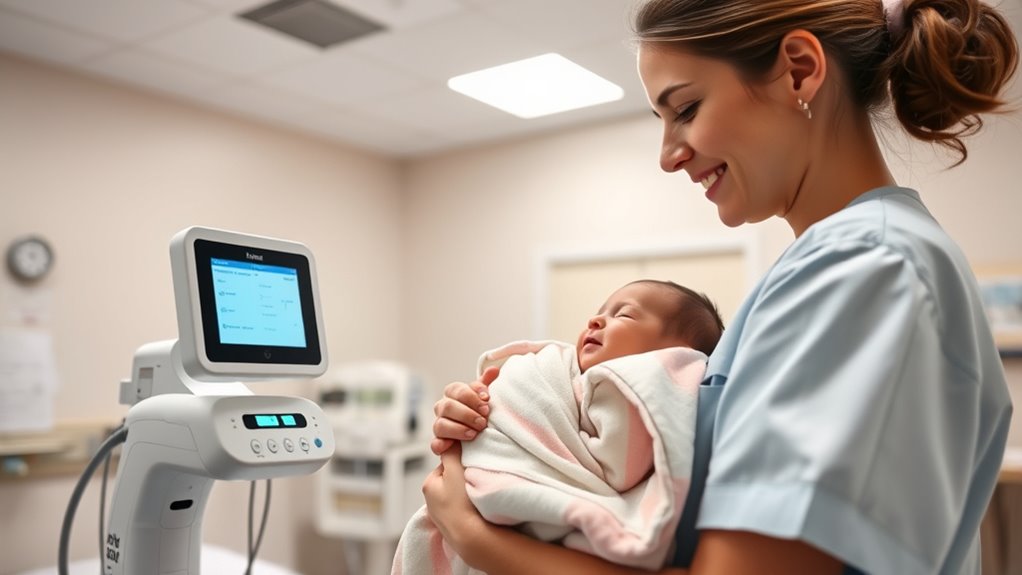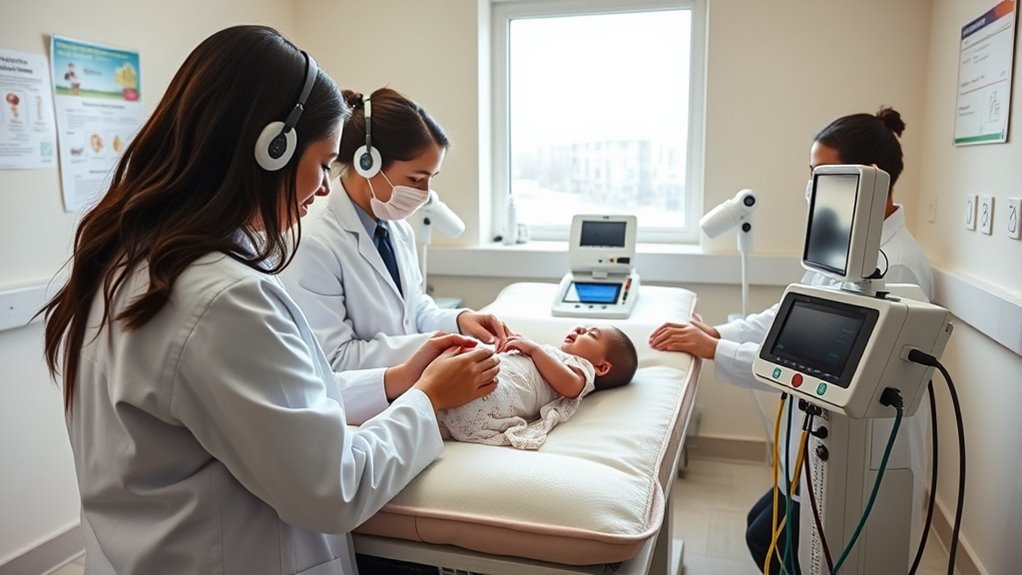Newborn screening tests are essential for catching health issues like hearing loss and metabolic disorders early on, so you can get your baby the help they need right away. These quick, painless tests are usually done before leaving the hospital and include hearing checks, blood tests, and oxygen scans. Early detection leads to better development, fewer health problems, and lower long-term costs. Keep exploring; you’ll find detailed information on each step to support your baby’s health journey.
Key Takeaways
- Newborn screening detects hearing loss and metabolic disorders early for timely interventions.
- Tests include hearing assessments, heel prick blood tests, pulse oximetry, and imaging.
- Screening is painless, quick, and performed within the first days after birth in hospital or clinics.
- Advances like tandem mass spectrometry and genetic testing improve detection accuracy.
- Follow-up and monitoring ensure effective treatment, reducing long-term health and developmental issues.
The Significance of Early Hearing Screening

Early hearing screening is essential because detecting hearing loss soon after birth allows for timely intervention, which substantially improves a child’s language and social development. When you identify hearing issues early, you can start therapy or use hearing devices promptly, preventing delays in speech and language skills. Screening is quick, non-invasive, and usually done before discharge from the hospital. This simple test can reveal hearing problems that might otherwise go unnoticed. By catching issues early, you give your child the best chance to develop normally and connect with others confidently, setting a strong foundation for their future growth and success. Hearing screening is a crucial step in ensuring early detection and intervention.
Common Metabolic Tests for Newborns

After hearing screening, newborns often undergo metabolic tests to detect hidden health conditions that aren’t immediately obvious. These tests typically involve a simple heel prick to collect a small blood sample. The most common metabolic screening tests check for conditions like phenylketonuria (PKU), hypothyroidism, and various amino acid or organic acid disorders. Early detection allows you to start treatment promptly, preventing serious health problems, developmental delays, or lifelong disabilities. The tests are quick, usually completed within a few minutes, and cause minimal discomfort. Your healthcare provider will analyze the blood samples in a lab and share the results with you. If any issues are identified, additional testing or treatment can be initiated early, ensuring your baby’s health and well-being. Essential resources and tips for caregivers and parents can help guide you through the process and support your child’s health journey.
Other Critical Screening Procedures

You need to understand the importance of other critical newborn tests that can detect life-threatening conditions early on. Advances in screening technologies are making these procedures faster and more accurate than ever before. Staying informed about these updates helps make certain your newborn gets the best possible care. Fathers’ support and guidance play a vital role in navigating these important health decisions.
Critical Newborn Tests
Have you ever wondered what essential screening procedures are performed on newborns beyond the standard tests? These additional tests help catch rare but serious conditions early. Here are four indispensable procedures:
- Blood spot screening – Checks for metabolic and genetic disorders like hypothyroidism and sickle cell disease.
- Pulse oximetry – Measures oxygen levels to detect congenital heart defects.
- Critical congenital heart defect screening – Uses pulse oximetry to identify heart problems not visible during physical exams.
- Imaging tests – Sometimes performed if other screenings suggest neurological issues or structural abnormalities.
- Additionally, portable home theatre projectors with high contrast ratios and accurate color reproduction can help create a comfortable environment for family bonding during recovery.
These tests provide critical information, ensuring early intervention and better health outcomes. They’re essential steps in safeguarding your newborn’s future health beyond routine screenings.
Screening Technologies Advances
Advancements in screening technologies have expanded the array of critical procedures used to detect rare but serious conditions in newborns. Modern tools like tandem mass spectrometry allow you to identify metabolic disorders quickly and accurately from a small blood sample. Hearing screening now employs automated otoacoustic emissions and auditory brainstem response tests, making it easier to catch hearing impairments early. New imaging techniques and genetic testing options help you detect conditions that were previously hard to diagnose. These innovations reduce false positives and speed up diagnosis, so you can start treatment sooner. As technology advances, your ability to identify and address health issues in newborns improves, ensuring that more babies receive the care they need immediately after birth. security vulnerabilities in new technologies can pose challenges that require careful evaluation and mitigation strategies.
How Screenings Are Conducted and What to Expect

Screenings for newborns are quick, simple tests usually performed within the first few days after birth. You might stay in a hospital or go to a specialized clinic for these screenings. The process is painless and typically takes just a few minutes. You’ll likely be asked to hold your baby still while the technician places small sensors or probes on their body or head. These tests measure responses or sounds to identify potential issues early. Here’s what you can expect:
Newborn screenings are quick, painless tests done early to detect potential health issues.
- Preparation: Your baby will be gently positioned, often while sleeping.
- Testing: Sensors are applied, and the procedure begins, often with gentle sounds or light touches.
- Monitoring: The technician observes responses and records data.
- Results: You’ll receive immediate feedback, and follow-up testing might be scheduled if needed.
Additionally, some screenings can detect conditions that may require specialized care, ensuring early intervention and better health outcomes for your newborn.
Benefits of Early Detection and Intervention

Detecting health issues early can lead to better outcomes and prevent serious complications. When problems are caught quickly, you can start treatment sooner, often improving your child’s quality of life. Plus, early intervention can lower long-term healthcare costs for families and the system. Implementing mindful decluttering strategies in the home can also create a more organized environment that supports ongoing health monitoring and reduces stress for caregivers.
Improved Health Outcomes
When newborns are screened early, healthcare providers can identify potential health issues before symptoms appear, allowing for timely intervention. This proactive approach leads to better health outcomes by addressing problems promptly. Early detection can prevent complications, improve development, and increase the chances of successful treatment. You’ll see significant benefits such as:
- Reduced risk of long-term disabilities
- Enhanced growth and development
- Increased chances of effective treatment
- Better overall health and well-being
Advancements in machine learning are increasingly supporting early diagnosis and personalized care plans, further improving outcomes for newborns.
Reduced Long-Term Costs
Have you ever considered how early intervention can save families and healthcare systems significant money in the long run? Detecting issues early means you can prevent costly complications later. When conditions are caught early, children need less extensive treatment, reducing hospital stays and specialist visits. This not only eases financial burdens but also improves quality of life. Imagine avoiding years of therapy, medication, or special education costs. Here’s how early screening benefits everyone:
| Immediate Savings | Long-Term Benefits |
|---|---|
| Reduced hospitalization costs | Fewer special education needs |
| Less intensive treatments | Better lifelong health outcomes |
Early detection of issues such as metabolic disorders can be crucial in preventing severe health problems.
Follow-Up and Ongoing Monitoring

After newborn screening tests are completed, ongoing monitoring becomes essential to guarantee any identified conditions are managed effectively. Regular follow-up ensures that treatment plans stay on track and any changes are promptly addressed. Your healthcare provider will schedule appointments to track your baby’s progress and adjust interventions as needed. Staying vigilant helps prevent complications and supports ideal development.
Here are four key aspects of follow-up and monitoring:
- Consistent medical checkups to assess health status
- Tracking developmental milestones
- Adjusting treatments based on progress
- Coordinating care among specialists when necessary
Frequently Asked Questions
When Should Parents Schedule the First Newborn Screening Appointment?
You should schedule your newborn’s first screening appointment as soon as possible after birth, ideally within the first few days. Early testing helps identify any health issues quickly, allowing for prompt treatment. Many hospitals conduct initial screenings before you leave, but if not, contact your pediatrician or local health department to set up an appointment. Acting early guarantees your baby gets the care they need for healthy development.
Are There Any Risks Associated With Newborn Screenings?
Think of newborn screenings as a gentle lighthouse guiding your baby’s health journey. There are minimal risks involved, mainly tiny discomforts like a quick heel prick or a small amount of blood. These procedures are safe, quick, and help catch potential issues early. You can rest assured that the benefits far outweigh the tiny risks, ensuring your little one gets the best start in life with early detection and care.
How Accurate Are the Screening Tests for Detecting Conditions?
You might wonder how reliable these tests are, and they’re generally very accurate. Most screening methods have high sensitivity and specificity, meaning they correctly identify most infants with the conditions and minimize false positives. However, no test is perfect, so sometimes results can be false alarms or missed cases. That’s why follow-up testing and consultation with healthcare providers are vital to confirm diagnoses and make sure your baby gets the right care.
What Happens if a Screening Test Indicates a Potential Problem?
Did you know that about 1 in 300 newborns may receive a false positive on screening tests? If a test indicates a potential problem, you’ll likely be asked to have your baby undergo further diagnostic testing. This step confirms whether your baby truly has the condition, helping you understand the next best actions. Remember, initial results are just a screening step, not a final diagnosis.
Can Screening Results Vary Between Different Hospitals or Clinics?
You might notice that screening results can differ between hospitals or clinics due to variations in equipment, testing protocols, and staff training. These differences can impact the accuracy and consistency of results. It’s important that you follow up with your healthcare provider if there’s any concern or if results are inconclusive. They can guarantee proper assessment and guide you on the next steps to support your child’s health.
Conclusion
Early screening for your newborn is like planting seeds for a healthy future. It helps catch potential issues early, giving your baby the best start in life. With quick, simple tests, you can guarantee their growth and development stay on track. Think of these screenings as a safety net, catching problems before they grow bigger. Taking these steps now means you’re giving your little one the foundation they need to thrive tomorrow.









